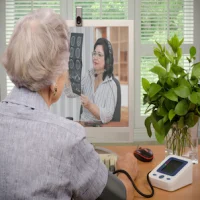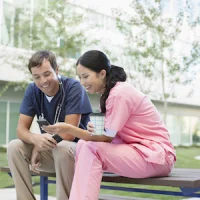A starter’s guide for radiologists unfamiliar with Twitter to highlight benefits of active Twitter involvement and remove perceived barriers to active Twitter use
The dominion of social media has transformed the way healthcare professionals and organisations connect with patients and interact with members and peers in the medical community. Being active on social media helps physicians improve patient outreach, improve how they interact with their peers and improve medical education and training.
In radiology specifically, trainees predominantly use social media as opposed to the lower rates of attending physicians who have been practicing for 15 years or more. Twitter and other social media platforms, put a face to radiology, helping patients and healthcare professionals see and comprehend the significant role radiologists play in the patient care continuum, their vital contributions to research, education and public health. A team of radiologists provide a simple Starter Guide to help their colleagues navigate the radiology Twitterverse published in The Journal of the American College of Radiology.
You may also like: Tweet, like, follow – radiology goes viral
The Radiology Twitterverse: A Starter’s Guide to Utilization and Success
Over the past decade, social media use has dramatically increased across medical specialties. Social media has changed how health care organisations and providers communicate with patients and interact with other members of the medical community. Benefits of social media in medicine, including improvements in patient outreach, peer-to-peer interactions, and medical education, have all been previously described. Although the majority of physicians have social media accounts, considerably less are actively engaged for professional purposes on a weekly basis. In radiology, use is predominantly seen among trainees with significantly lower rates seen in radiologists who have been in practice for over 15 years.
Difficulty maintaining separation between professional and personal accounts is a common concern among physicians using social media. Twitter (San Francisco, California), a microblogging social media platform, limits this potential crossover, while offering additional features to assist radiologists in advancing their professional goals. With over 280 million active monthly users, Twitter represents the fastest growing social media platform, offering the ability to rapidly disseminate online content to a diverse audience. However, numerous barriers exist that may prevent radiologists from joining Twitter, including perceived difficulty of use, privacy concerns, and lack of academic benefit. Apprehension about the time commitment needed to maintain an active Twitter account is another factor that may discourage use. These sentiments are quickly overcome once Twitter use is initiated.
Twitter, along with other social media platforms, puts a face to radiology, helping both patients and other health care professionals understand the contribution of radiologists to patient care, research, education, and public health. We aim to provide a starter’s guide for radiologists unfamiliar with Twitter (1) to highlight benefits of active Twitter involvement and (2) to remove perceived barriers to active Twitter use.
Benefits of Twitter Use
Personal Branding
Personal branding is the process of an individual, group, or organization establishing a prescribed image or impression in the minds of others. It is an ongoing process that requires frequent reinforcement that eventually helps to differentiate one entity from another. In medicine, personal branding allows health care organizations and providers to market their abilities, services, and partnerships, which may, in turn, increase patient volume and improve relationships with colleagues.
However, radiologists face unique challenges when branding on social media platforms compared with other physicians; nearly one-half of patients do not know that radiologists are physicians and nearly two-thirds do not understand their role in patient care. By providing a constant stream of valued content online over time, radiologists can increase their presence and improve their overall perception. Moreover, radiologists and organizations can also use their Twitter timeline to favorably portray activities including awards, lectures, and upcoming events to news, media, and the general public. This process of “self-packaging”—creating one’s own personal narrative—is a marketing strategy that can lead to increased visibility and establishing oneself as an influencer, trusted authority, and thought leader.
Patient Outreach
Twitter offers the ability to rapidly disseminate content to a large, diverse audience. Prior studies have shown that up to 80% of Internet users seek medical information online. Twitter can be used to provide patients with evidence-based health information to help support medical decision making, which can be targeted to patient groups likely to be seen at a particular practice. Personal branding can be used to demonstrate professional credibility by allowing patients to assess medical expertise and services. Marketing directly to patients, in addition to health promotion, can also be used to provide information on how to gain access to medical services, educational resources, and community events. This form of direct patient outreach can be leveraged to reach underserved populations, including rural communities, who may not readily have access to medical care.
Radiologists can also communicate with patients on issues directly related to radiology including issues related to imaging examinations, radiation risk, and contrast administration. Lastly, real-time feedback about radiologic services can be received from patients, which can help radiologists improve their services. This has been shown previously with initiatives involving patient feedback through Twitter about their experience receiving MRI and breast imaging.
Health Care and Advocacy Initiatives
Twitter can be used to influence policy and to promote health care initiatives related to radiology by connecting policymakers, medical professionals, patients, and media sources. It provides an avenue for direct involvement among stakeholders, which can be used to galvanize people with similar interests for a particular purpose. Live polling and tweet chats (a group chat at a predetermined time that involves tweeting questions to prompt participant responses) on a particular topic helps to gauge public perception, and the fast-paced interactive environment allows for quick dissemination of emerging information and upcoming events. This can be particularly useful when promoting timely policy initiatives and engaging elected officials during lobbying days at the state and federal levels.
Twitter has proven to be an effective way of promoting radiology initiatives. With women representing only 21% of the radiology workforce, Twitter was utilised to improve access to mentorship and to encourage inclusivity by creating a mentorship network among female radiologists. A series of tweet chats, also occurring during annual meetings including RSNA, helped to bring awareness about this initiative. Now, the widely used hashtags #RADxx and #RADWomen are synonymous with this mission.
Networking
Online networking enhances communication and collaboration among colleagues. Currently, 60% of radiologists use social media for professional networking, which can be used to form important partnerships. It provides an innovative avenue for radiologists at all career levels to communicate with experts and thought leaders in the field. Additionally, the Twitter search function makes it possible to find users with similar interests by searching relevant words and usernames, as well as recommending others to follow. These tools support interactions among radiologists, which can be further developed through mutual retweeting, replying to tweets, and direct messaging.
Interactions between attendees at scientific meetings has been greatly enhanced by social media use in recent years. There was an 83% increase in Twitter use at the American Society of Clinical Oncology meeting from 2010 to 2011 and a 39% increase in use at the RSNA meeting from 2011 to 2012. It is now customary for meetings to create their own hashtag, which has been traditionally used by attendees to capture meeting highlights. These same hashtags can also be searched after the conference for reference material to use for research purposes, to assist in medical decision making, and to archive meeting highlights. Additional features, including live polling, have been shown to improve the overall meeting experience, while capturing sentiments of attendees during the course of the conference.
Medical Education
Twitter can be a powerful tool at facilitating medical education by improving engagement and collaborative thinking. It enhances information exchange in learning environments by removing geographic barriers and increasing access to scientific material. For example, cross promotion of Twitter across social media platforms such as Periscope (San Francisco, California) can be used to share information through lectures and journal clubs.
In addition, tweet chats can be performed to educate on a particular topic utilising images and administering quizzes. Twitter can also be used as an avenue for presenting interesting cases and receiving feedback from colleagues about how to handle difficult clinical scenarios. Lastly, many academic journals now share links to journal articles, providing efficient and immediate access to recently published literature.
Creating a Twitter Account
When considering creating a Twitter account, the process can be daunting at first. The first step is to visit the Twitter website or to download the Twitter application (app) on your mobile device. One of the most important decisions you will make is determining your username or “handle,” which is one of the first actions you will take. Your username will be included in the URL (Universal Resource Locator) of your Twitter address. Ensure you personalise your username, so that others can easily find you. For professional accounts, consider using your name followed by your professional degree (eg, @JohnSDoeMD). This will help patients and colleagues identify you as a medical professional. Consider using a middle initial or combining your name with your hospital affiliation or subspecialty to differentiate you from others with similar names.
The next step is filling out your profile. A professional profile photo is an important step in putting a face to your account, especially for radiologists who may not interact often with patients or referring physicians in person. Next, the biography section is a great way to inform potential followers about your background, interests, and qualities. This section currently consists of 160 characters, so brevity is key in maximising the amount of information shared in this space. Consider using common acronyms, hashtags, and abbreviations to provide as much information as possible. This is also a great space to introduce yourself as a doctor, including your medical subspecialty and hospital, organisation, or institutional affiliation. Consider visiting successful profiles of other users with similar academic interests for help with branding your account.
Who to Follow
There are numerous applications that can assist in suggesting users to follow including Hootsuite (Vancouver, British Columbia, Canada) and Sprout Social (Chicago, Illinois). Over time, Twitter will provide suggestions for users to follow based off your activity. When actively searching for users, consider searching for experts and thought leaders in your field, colleagues with similar research interests, and academic journals related to your specialty. As you follow more users, begin exploring their following and follower lists to find other users who may be appropriate to follow. Lastly, searching words and participating in tweet chats related to topics of interest are other great ways to find users who may share useful and relevant content.
Ready to Tweet
It is helpful to create a strategy before joining the “Twitterverse.” When creating a strategy, the first step is devising your personal goals for your account. Your goals will determine what, when, and how often you tweet. Another consideration is your target audience. Tweets directed toward patients will be markedly different from tweets intended for physicians or other medical professionals. Your messaging should be easily interpretable by your target group. While shaping your social media strategy, consider beginning by liking and retweeting others’ tweets. Likes and retweets are both saved in your account’s history, so make sure that these actions match your intended messaging for your Twitter profile.
Original tweets are limited to 280 characters and can include photos, links, GIFs (graphics interchange format), or videos. Tweets should be clear and concise, utilising common acronyms and abbreviations, when possible, to create more space for content (Figure 1). Append hashtags (written with the symbol #) to words to make tweets more identifiable and searchable. Hashtags index keywords and allow other users to follow recent tweets on a specific topic. Additionally, by clicking on a hashtagged word, other tweets including that word will be displayed. This can be leveraged to increase exposure to your Twitter timeline by attracting other users looking for information on a particular topic to your account. The radiology hashtag ontology was created to organise radiology-related content from social media platforms to facilitate conversations about imaging related health care, which can be used to support hashtag creation.
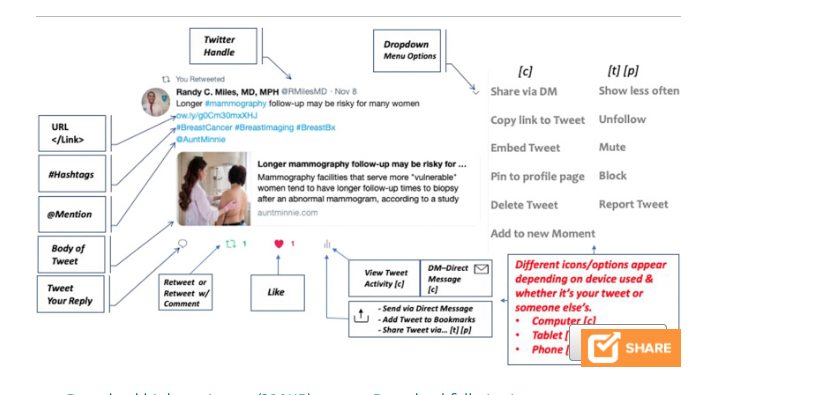
Fig 1. Anatomy of a tweet.
Other tips include: adding “handles” (@mentions) of other users, who may be related to your tweets to increase engagement; including images, in which you can tag up to 10 people, and adding links such as to articles to improve the content of your tweet. Websites and mobile apps such as Hootsuite now allow users to schedule their tweets so that a stream of tweets can be shared throughout various times of the day to maintain a constant Twitter presence regardless of a busy schedule.
Tweet Chats
A tweet chat (also known as a Twitter chat) is a useful tool for discussing a particular topic, which has been leveraged to increase participation at scientific meetings and engage users all year round. It is a group chat with a host and/or moderator tweeting questions to prompt responses from participants that occurs at a predetermined time on Twitter, where users include a predefined hashtag(s) in their tweets to link and follow the conversation. These chats usually last about an hour depending on the question-and-answer format. At scientific meetings, tweet chats allow meeting attendees to comment on sessions, while engaging with other attendees and nonattendees. Overall, it allows for networking among colleagues and provides the opportunity to discuss trending topics.
There are websites and mobile apps specific to tweet chats, which can help users keep up with the fast-paced environment by organising and streaming tweets for easier conversing. Websites such as TweetChat.com (London, UK) help to facilitate this process by automatically adding predetermined hashtags to your tweets during a tweet chat.
It is beneficial to participate in tweet chats before deciding to host or moderate. When you are ready, ensure a hashtag is chosen that is relevant, concise, and clear. If possible, try to choose a hashtag that relates to your organisation or personal mission, which may enhance branding. It is important to have questions prepared in advance to ensure the group chat flows in a streamlined manner. Also, consider inviting special guests in addition to moderators to lend their expertise and to increase engagement.
The next step is to schedule your tweet chat. One factor to consider is the geographic location of your intended audience. If involving multiple time zones, consider scheduling at a central time to maximise participation. Also, try to schedule your tweet chats at a time when it does not conflict with other scheduled tweet chats on similar topics, which may result in less participation for your tweet chat. A list of scheduled tweet chats can be found on Tweetreports.com (Mt Juliet, Tennessee). Once the date is set, post tweets promoting details about your tweet chat including title, host, and time. Once the chat begins, the focus turns to managing conversation, sharing relevant resources, and keeping participants engaged. Frequently used terms and abbreviations are listed in Table 1.
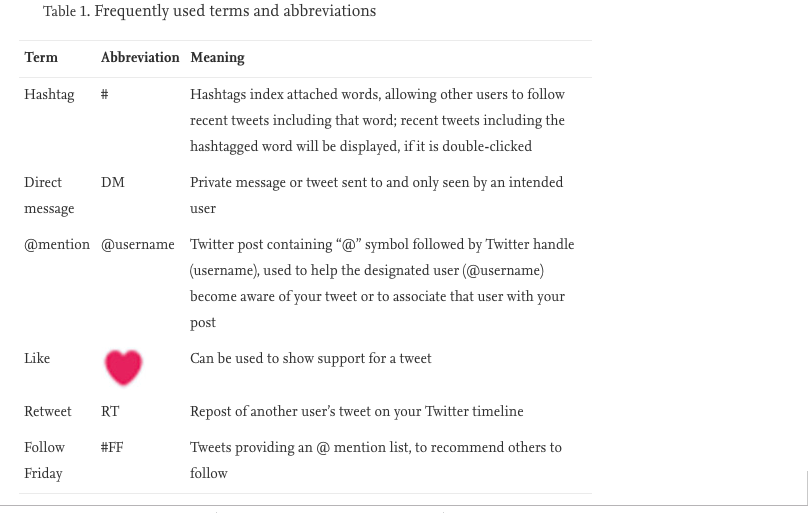
Academic Promotion
Although academic promotion and tenure committees have previously focused on three different tracks including clinical, research, and education, other benchmarks for promotion are emerging in areas of leadership, innovation, and quality improvement. Social media presence has now surfaced as a field of scholarship within these new areas by some organisations. Digital footprints left by social media use can be converted into performance metrics, in addition to metrics of publication history and grant funding.
However, using social media as a measure for scholarly activity is relatively new. Therefore, processes to measure and promote based off social media productivity have not been implemented at most programs. When considering using social media as a promotion tool, it is important to check with your tenure committee about specific promotions criteria. Recommendations for academic institutions implementing social media and digital scholarship for promotion include developing guidelines governing faculty in this area, providing training on appropriate use of social media, and outlining the type of social media activities considered scholarly work. Promotion based on social media presence does share numerous similarities to traditionally utilised metrics including developing an area of concentration, expanding your audience, and consistently disseminating new knowledge. Hootsuite, a dashboard application that tracks activity across social media sites, can provide information on metrics to help assess productivity. It is one of many free online Twitter tools and apps (Table 2) available to improve your Twitter experience.
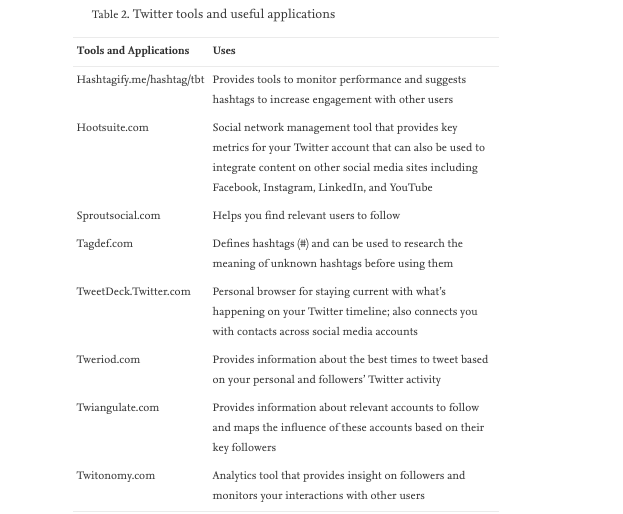
Social Media Pitfalls
There are numerous pitfalls associated with Twitter use that should be avoided (Table 3). First, it is important to review your professional organisation’s social media policies, if available, to avoid violating established guidelines. Issues related to patient privacy and confidentiality, in particular, are commonly covered topics by hospitals and health care organisations. For example, when posting interesting cases or obtaining advice about diagnostic dilemmas, great strides should be taken to ensure patient information and images are appropriately anonymised to avoid HIPAA violations.
Next, issues can arise from blurring of professional and personal content. Although it is not necessary to have separate accounts, tweeting about nonscientific topics, especially when controversial, may undermine professional branding goals. Next, it is important to understand the source and meaning behind shared content. For example, unfamiliar hashtags may have unintended meanings or come from unknown sources that may conflict with your messaging goals. This can be easily prevented by researching content that you share and only sharing information that is aligned with your account’s mission. Also, try not to over “hashtag.” Although proper hashtagging may help users with similar interests discover your profile, hashtagging nonspecific terms or words that do not directly relate to the core of your tweet are not effective. Additionally, too many hashtags, especially when irrelevant, may make your tweets incomprehensible. Lastly, Twitter is a virtual environment where users can share their opinions freely. It is important to remain professional when addressing someone with opposing views and to avoid overly negative interactions when disagreements arise.

Summary
There have been numerous calls for radiologists to increase their social media presence. The ability to reach a large, diverse audience, including experts, colleagues, referring physicians, trainees, policymakers, and patients, can be a useful tool in increasing the presence of radiology in the online community. A vibrant radiology Twitterverse currently exists, and if you have not already joined the ranks, there is no better time than now to see what this online world has to offer.
Take-Home Points
- Over the past decade, social media use has dramatically increased across medical specialties, changing how health care organizations and providers communicate with patients and interact with other members of the medical community.
- Benefits of social media in radiology include enhanced patient outreach, peer-to-peer interactions, health care and advocacy initiatives, mentorship and sponsorship, medical education, and personal branding.
- Twitter, along with other social media platforms, puts a face to radiology, helping both patients and other health care professionals understand the contribution of radiologists to patient care, research, education, and public health.
Image credit: iStock
References:
J.K. Hoang, J. McCall, A.F. Dixon, et al. Using social media to share your radiology research: how effective is a blog post? J Am Coll Radiol, 12 (2015), pp. 760-765
C.M. Hawkins, R. Duszak, J.V. Rawson Social media in radiology: early trends in Twitter microblogging at radiology’s largest international meeting J Am Coll Radiol, 11 (2014), pp. 387-390
S.S. Patel, C.M. Hawkins, J.V. Rawson, et al. Professional social networking in radiology: who is there and what are they doing? Acad Radiol, 24 (2017), pp. 574-579
F.J. Grajales III, S. Sheps, K. Ho, et al. Social media: a review and tutorial of applications in medicine and health care J Med Internet Res, 16 (2014), p. e13
P.M. Prasanna, F.J. Seagull, P. Nagy Online social networking: a primer for radiology
J Digit Imaging, 24 (2011), pp. 908-912
B.S. McGowan, M. Wasko, B.S. Vartabedian, et al. Understanding the factors that influence the adoption and meaningful use of social media by physicians to share medical information J Med Internet Res, 14 (2012), p. e117
A. Radmanesh, A.L. Kotsenas Social media and scientific meetings: an analysis of Twitter use at the annual meeting of the American Society of Neuroradiology AJNR Am J Neuroradiol, 37 (2016), pp. 25-27
E.R. Ranschaert, P.M. Van Ooijen, G.B. McGinty, et al. Radiologists’ usage of social media: results of the RANSOM survey J Digit Imaging, 29 (2016), pp. 443-449
eMarketer.com Which social networks are growing fastest worldwide?
Available at: http://www.emarketer.com/Article/Which-Social-Networks-Growing-Fastest-Worldwide/1009884, Accessed 23rd May 2018
D. Lair, K. Sullivan, G. Cheney Marketization and the recasting of the professional self
Manage Commun Q, 18 (2005), pp. 307-343
P. Miller, R. Gunderman, J. Lightburn, et al. Enhancing patients’ experiences in radiology: through patient-radiologist interaction Acad Radiol, 20 (2013), pp. 778-781
G.M. Glazer, J.A. Ruiz-Wibbelsmann The invisible radiologist Radiology, 258 (2011), pp. 18-22
R.F. Munden
Marketing and branding for a radiologist
J Am Coll Radiol, 12 (2015), pp. 130-131
H.H. Tso, J.R. Parikh
Leveraging Facebook to brand radiology
J Am Coll Radiol, 15 (2018), pp. 1027-1032
S. Fox
The social life of health information 2011. Pew Research Center
Available at:
http://www.pewinternet.org/2011/05/12/the-social-life-of-health-information-2011/, Accessed 15th Aug 2018
H.M. Bik, M.C. Goldstein
An introduction to social media for scientists
PLoS Biol, 11 (2013), Article e1001535
J. Alexander, H.T. Kwon, R. Strecher, et al.
Multicultural media outreach: increasing cancer information coverage in minority communities
J Cancer Educ, 28 (2013), pp. 744-747
A.B. Rosenkrantz, A. Labib, K. Pysarenko, et al.
What do patients tweet about their mammography experience?
Acad Radiol, 23 (2016), pp. 1367-1371
J. Hewis
Do MRI patients tweet? Thematic analysis of patient tweets about their MRI experience
J Med Imaging Radiat Sci, 46 (2015), pp. 396-402
B.S. Kelly, C.E. Redmond, G.J. Nason, et al.
The use of Twitter by radiology journals: an analysis of Twitter activity and impact factor
J Am Coll Radiol, 13 (2016), pp. 1391-1396
E.I. Bluth, S. Bansal, C.E. Bender
The 2017 ACR Commission on Human Resources Workforce survey
J Am Coll Radiol, 14 (2017), pp. 1613-1619
A.K. Patel, J. Fielding, K.J. Macura, et al.
Women’s leadership in the ACR, 2001-2015
J Am Coll Radiol, 14 (2017), pp. 830-837
M. Retrouvey, B. Keefe, A. Kotsenas, et al.
Women in radiology: creating a global mentorship network through social media
J Am Coll Radiol, 15 (1 Pt B) (2018), pp. 229-232
D.J. Attai, D.M. Radford, M.S. Cowher
Tweeting the meeting: Twitter use at The American Society of Breast Surgeons Annual Meeting 2013-2016
Ann Surg Oncol, 23 (2016), pp. 3418-3422
T. Desai, A. Shariff, A. Shariff, et al.
Tweeting the meeting: an in-depth analysis of Twitter activity at Kidney Week 2011
PLoS One, 7 (2012), Article e40253
E.S. Schwenk, K.M. Jaremko, R.K. Gupta, et al.
Upgrading a social media strategy to increase Twitter engagement during the spring annual meeting of the American Society of Regional Anesthesia and Pain Medicine
Reg Anesth Pain Med, 42 (2017), pp. 283-288
C.M. Hawkins, B.J. Hillman, R.C. Carlos, et al.
The impact of social media on readership of a peer-reviewed medical journal
J Am Coll Radiol, 11 (2014), pp. 1038-1043
Symplur.com
Radiology tag ontology
Available at:
https://www.symplur.com/healthcare-hashtags/ontology/radiology/, Accessed 1st Feb 2019
T. Kind, P.D. Patel, D. Lie, et al.
Twelve tips for using social media as a medical educator
Med Teach, 36 (2014), pp. 284-290
B. Casey
Radiology’s top tweeters: Dr. Geraldine McGinty
Available at:
http://bit.ly/1eJeJv1, Accessed 30th Jul 2018
V. Kalia, D.A. Ortiz, A.K. Patel, et al.
Leveraging Twitter to maximize the radiology meeting experience
J Am Coll Radiol, 15 (1 Pt B) (2018), pp. 177-183
C.C. Cheston, T.E. Flickinger, M.S. Chisolm
Social media use in medical education: a systematic review
Acad Med, 88 (2013), pp. 1-9
D. Cabrera, B. Vartabedian, R. Spinner, et al.
More than likes and tweets: creating social media portfolios for academic promotion and tenure
J Grad Med Educ, 9 (2017), pp. 421-425
Latest Articles
Imaging, MRI, Radiology, RSNA, breast imaging, mobile apps, social media, Twitter, HIPAA, hashtags, medical education, information, Academic Radiology, JACR, #RadXX, online patient health, personal branding, Twitterverse, Twitteratti, #RADWomen, American Society of Clinical Oncology, Periscope, Hootsuite, Sprout Social, Tweet Chats, the journal of the American college of radiology, hashtag, handle, GIFs
The dominion of social media has transformed the way healthcare professionals and organisations connect with patients and interact with members and peers in the medical community. Being active on social media helps physicians improve patient outreach, imp






